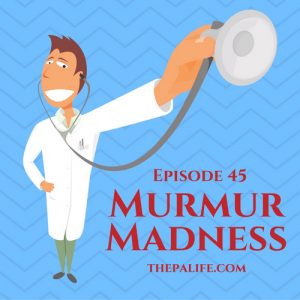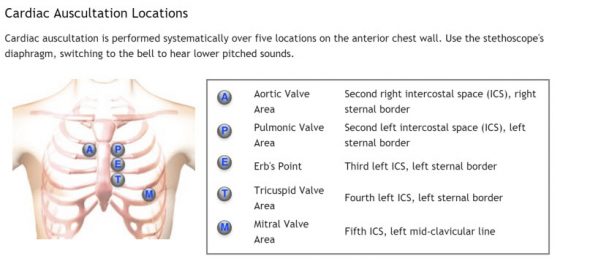Podcast: Play in new window | Download
Subscribe: Apple Podcasts | RSS
 Welcome to episode 45 of the FREE Audio PANCE and PANRE Physician Assistant Board Review Podcast.
Welcome to episode 45 of the FREE Audio PANCE and PANRE Physician Assistant Board Review Podcast.
Today we are going to take a brief detour away from 10 daily questions and instead cover the murmurs you need to know for your PANCE and PANRE exam.
I have still included an 11 question exam at the end of this post so make sure you scroll down after you listen to the podcast.
There are a total of 17 cardiac conditions that may present on exam day in the form of a descriptive sound/murmur.
You will often be given supporting evidence such as the location of auscultation or radiation which you can use to narrow down your options.
There are total of 51 cardiac topics in the NCCPA™ Cardiology PANCE and PANRE Content Blueprint which represents 16% of the PANCE and PANRE exam.
(click here to download the FREE NCCPA Content Blueprint cheat sheet)
These cardiac conditions and their associated murmurs cover a whopping 33% of the cardiology section of the PANCE and PANRE exam!
Take a listen to this week’s podcast episode
If you can’t see the audio player click here to listen to the full episode.
Let’s break this all down:
Each of the links below opens the corresponding lesson on SmartyPANCE and is available to members (you must be logged in or join now)
There are 9 valvular disorders associated with murmurs:
Valvular Disorders (PEARLS and Flashcards)
- Aortic stenosis (ReelDx)
- Aortic regurgitation (Diastolic Murmur)
- Mitral stenosis (Diastolic)
- Mitral regurgitation
- Mitral valve prolapse
- Tricuspid stenosis
- Tricuspid regurgitation
- Pulmonary stenosis
- Pulmonary regurgitation
Five congenital heart diseases that have corresponding murmurs
Congenital Heart Diseases (PEARLS)
- Atrial septal defect
- Coarctation of the aorta
- Patent ductus arteriosus
- Tetralogy of Fallot
- Ventricular septal defect
One murmur associated with cardiomyopathy
And a pair of conditions nested under the label of “other forms of heart disease” that have associated murmurs/heart sounds worth mentioning
Other Forms of Heart Disease (PEARLS)
Making Sense of Murmurs
Let’s start with the valvular disorders:
You have 4 heart valves with two main conditions – half are diastolic murmurs and half are systolic murmurs. Here is a helpful mnemonic:
Recalling Common Systolic Heart Murmurs: MR PASS
- M itral
- R egurgitation
- P hysiologic (also known as functional, systolic flow murmur, a heart murmur heard in the absence of cardiac abnormality)
- A ortic
- S tenosis
- S ystolic – All the above murmurs are heard during systole.
MR PASS wins the Most Valuable Player award.
- M itral
- V alve
- P rolapse – Add MVP as another systolic murmur.
MR PASS often hangs around with MS ARD.
- M itral
- S tenosis
- A ortic
- R egurgitation
- D iastolic – All the above murmurs are heard during diastole.
Here are the nine valvular murmurs and their associated descriptions
Remember which are systolic and diastolic this can be very helpful at ruling out or ruling in a condition come exam day.
- Aortic Stenosis – Systolic harsh ejection crescendo decrescendo murmur at RUSB (aortic area) with radiation to the neck and apex
- Aortic Regurgitation – diastolic – soft high pitched blowing at LSB with patient sitting leaning forward and exhaling
- Mitral stenosis – diastolic – low pitched decrescendo rumbling with opening snap at the APEX (the mitral area) enhanced by expiration
- Mitral regurgitation – blowing holosystolic murmur loudest at the APEX (the mitral area) with a split S2 that radiates to the axilla and is increased by squatting, handgrip and expiration
- Tricuspid Stenosis – diastolic – mid diastolic rumbling at LLSB (tricuspid area) with opening snap
- Tricuspid regurgitation – High pitched holosystolic blowing murmur that radiates to the LSB (tricuspid area)
- Pulmonic stenosis – harsh midsystolic ejection crescendo-decrescendo murmur with widely split s2 at LSB that radiates to the left shoulder and neck
- Pulmonic regurgitation – diastolic – high pitched, decrescendo murmur at LUSB increase with inspiration
- Mitral valve prolapse – Midsystolic ejection click head best at the APEX (the mitral area)
With these valvular murmurs you have 4 auscultation points which can be easily remembered using the mnemonic APT Ment watch this amazing video so you never forget!
Another helpful mnemonic: Aortic Pulmonic Tricuspid Mitral – A ll P hysicians T ake M oney!
- Aortic area: right 2nd interspace (Right upper sternal border RUSB)
- Pulmonic area: 2nd left interspace (Left upper sternal border LUSB)
- Tricuspid area: Left lower sternal border LLSB
- Mitral area: APEX
You can use the auscultation point to successfully narrow down your murmur and use the designation of systolic or diastolic to narrow down even further.
Five congenital heart diseases that have corresponding murmurs
Congenital Heart Diseases (PEARLS)
- Atrial septal defect – Systolic ejection murmur at 2nd left intercostal space with an early to mid-systolic rumble and fixed splitting of the 2nd heart sound (s2) and CXR will show pulmonary vascular markings.
- Coarctation of the aorta – Late systolic ejection murmur-posterior or continuous murmur if collateral flow. Will have absent or weak femoral pulses with a delay of palpable femoral pulse and HTN in arms but low or normal blood pressure in the legs
- Patent ductus arteriosus – Continuous, rough, machinery-like murmur, heard best in the first interspaces of the LSB
- Tetralogy of Fallot – Harsh systolic ejection murmur heard best at the left sternal border. Associated with bluish skin, trouble gaining weight, and sudden loss of consciousness during crying or feeding
- Ventricular septal defect – Harsh high pitched holosystolic murmur heard best at the LSB with ride radiation and a fixed split S2
Several of these conditions have a “tell” that make it easy to identify the condition and they are usually always part of the root of the question.
- PDA = machinery like murmur (remember that the physician assistant got a patent on his machine).
- Tetralogy of Fallot usually presents with a young child having TET spells which are described as bluish skin, trouble gaining weight, and sudden loss of consciousness during crying or feeding.
- Coarctation will almost always present with absent or weak femoral pulses with a delay of palpable femoral pulse and HTN in arms but low or normal blood pressure in the legs.
- ASD is a bit tougher but they will usually give you a wide and fixed splitting of the S2 and patients will be easily fatigued. CXR will show pulmonary vascular markings.
- VSD will have a high pitched holosystolic murmur and newborns may show dyspnea.
One murmur associated with cardiomyopathy
- Hypertrophic cardiomyopathy – Medium-pitched, mid-systolic murmur that decreases with squatting and increases with straining. S4 gallop and apical lift with thick, stiff left ventricle. HCM is the leading cause of sudden death in athletes and may cause angina.
And a pair of conditions nested under the label of “other forms of heart disease” that have associated murmurs/heart sounds worth mentioning
Other Forms of Heart Disease (PEARLS)
- Acute and subacute bacterial endocarditis – A new mitral regurgitant murmur in a patient with a history of IVDA, fever (39.0º C),* and a blood culture that reveals 2 out of 2 positive growth
- Acute pericarditis – Although this is not a murmur, it is important to identify a pericardial friction rub heard best with patient upright and leaning forward. Chest pain is also relieved by sitting and/or leaning forward
You can listen to all these murmurs and see their associated waveforms at www.smartypance.com/courses/cardiology
Here is a wonderful video from the Khan Academy of how to approach murmurs video of murmurs
Murmur Flash Cards
Episode 45 PANCE and PANRE Murmur Quiz
You will see from these questions on the PANCE and PANRE things aren’t always so straightforward.
You can take the exam here: thepalife.com/murmur-madness
Looking for all the podcast episodes?
This FREE podcast series is limited to every other episode, you can download and enjoy the complete audio series by joining The PANCE and PANRE Exam Academy + SmartyPANCE
I will be releasing new episodes every few weeks. The Academy is discounted and now includes complimentary access to SmartyPANCE so sign up now.
Included is a full cardiology content blueprint board review exam with over 147 cardiology specific questions and 51 cardiology blueprint topics covered in detail. This is in addition to 1,000’s of additional board review questions and NCCPA content blueprint courses covering all 13 organ areas.
I am also happy to introduce ReelDX™ patient case based integration into many of the SmartyPANCE blueprint lessons. It’s like a virtual rotation from the comfort of your couch!
This podcast is available on iTunes and Stitcher Radio (among others)
- iTunes: The Audio PANCE AND PANRE Podcast iTunes
- Stitcher Radio: The Audio PANCE and PANRE Podcast Stitcher

